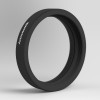- Astronomik Lunar calendar for 2024
The Astronomik calendar of the Lunar phases in 2024 is ready.
- Chistmastime and New Year 2023-2024
We wish you a merry Chirstmastime and a happy and healthy 2024...
- Astronomik Lunar calendar for 2023
The Astronomik calendar of the Lunar phases in 2023 is ready.
- Chistmastime and New Year 2022-2023
We wish you a merry Chirstmastime and a happy and healthy 2023...
- Shipping methods
Shipping as registred good shipment is no longer available
- How to observe planetary nebulae
A very nice introduction to observing planetary nebulas written by Owen Brazell
Astronomik MC-clear Filter

Click the image for full resolution
This Multicoated (MC) glass serves as dust protector or to keep your system parfocal with other Astronomik filters.This filter should be used if the focal plane of your imaging system should stay in the same place as with other Astronomik filters in place. The multicoating prevents you from unwanted reflections. It blocks neither IR nor UV.
The second main application is dust protection of your system (telescope or camera). As the filter doesn’t modify the spectral transmittance of your system it doesn’t alter the colors. It’s great for keeping all dust away from your optics or sensor.
Lots of Astronomik MC Clear filters in custom diameters are sold to camera manufacturers worldwide. They like the great coating and scratch resistance!
Main use
The Astronomik MC Clear is made by the same high-end process as all other Astronomik filters. The coating has the same scratch resistance and the substrate has the same high quality. Because of this it is parfocal with all other Astronomik filters and can be used in any optical system for dust protection without modifying the spectral characteristics and without destroying the optical performance of your system.
Other uses
- As a dust protection of Schmidt-Cassegrain, Schmidt-Newton or Maksutov system or as a dust protection in front of DSLR camera.
- As an alternative instead of the UV-IR-Blocker if your system has no refracting elements.
Alternatives
You should think about using the IR-blocker or even the UV-IR blocker if you have a system with any refracting elements.
more information about the photographic Astronomik filters
How to read the chart
The major emission lines of artifical light pollution:
| Hg 435,8nm | Hg 546,1nm | Hg 577,0nm | Hg 578,1nm |
| Na 589,0nm | Na 589,6nm | Na 615,4nm | Na 616,1nm |
The major emission lines of nebulas:
H-β 486,1nm | OIII 495,9nm | OIII 500,7nm | H-α 656,3nm
- The horizontal axis is the Wavelength in Nanometers (nm). 400nm is deep blue, at 520nm the human eye senses green and at 600nm red. At 656nm is the famous "H-Alpha" emission line of hydrogen.
- The transmission in % is plotted on the vertical axis.
- The red line shows the transmission of the filter.
- Visual filters: The grey line in the background shows the relative sensitivity of the human eye at night. The maximum is at ~510nm and drops to longer and shorter wavelengths. You can easily see, that you can´t see anything of the H-alpha line at night (even if you can during daylight!) The sensitivity at 656nm is 0% at night!
- Photographic filters: The grey line in the background shows the sensitivity of a typical CCD sensor.
- The most important artifical emission lines are shown in orange. The artifical light pollution is dominated by see mercury (Hg) and sodium (Na), which are used in nearly all streetlights.
- The most important emission lines from nebulas are shown in green. The most important lines are from ionized Hydrogen (H-alpha and H-beta) and double ionized oyxgen (OIII).
The major emission lines of artifical light pollution:
| Hg 435,8nm | Hg 546,1nm | Hg 577,0nm | Hg 578,1nm |
| Na 589,0nm | Na 589,6nm | Na 615,4nm | Na 616,1nm |
The major emission lines of nebulas:
H-β 486,1nm | OIII 495,9nm | OIII 500,7nm | H-α 656,3nm
Suitability
- Visual observation (dark skies): Reasonable, for dust protection only
- Visual observation (urban skies): Reasonable, for dust protection only
- Film photography: Reasonable, for dust protection only
- CCD photography: Good, to compensate the optical thickness (parfocal with other Astronomik filters); dust protection
- DSLR photography (original): Reasonable, for dust protection only
- DSLR photography (astro modified): Reasonable, for dust protection only
- DSLR photography (MC modified): Reasonable, for dust protection only
- Webcam / Video (Planets): Reasonable, for dust protection only
- Webcam / Video (Deep Sky): Reasonable, for dust protection only
Technical Data
- Parfocal with other Astronomik filters
- Glass thickness: 1mm
- Completely resistant against high humidity, scratches and aging effects
- Diffraction limited, the filter will not reduce the optical performance of your telescope!
- Astronomik filters are delivered in a high-quality, long lasting, filter box
- Since 2008 we do ship filters with a completely new design. Any kind of halo or strange reflection is a matter of past
The filter is available in the following sizes
Filter displayed products below by their features
- Remove This Item Size: T-thread cell (M42x0,75)

 Deutsch
Deutsch English
English




